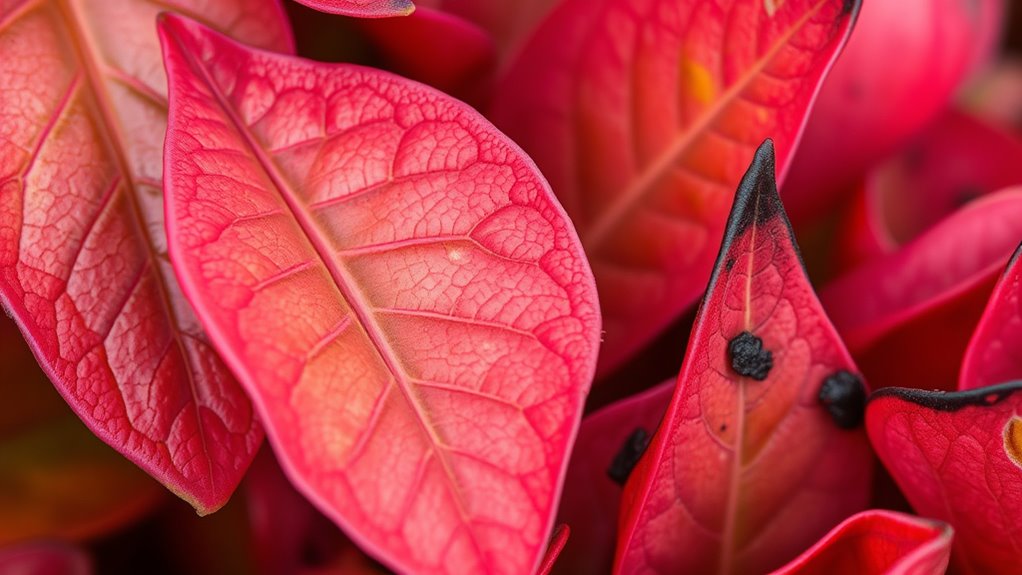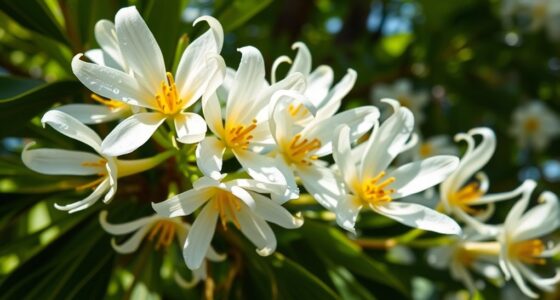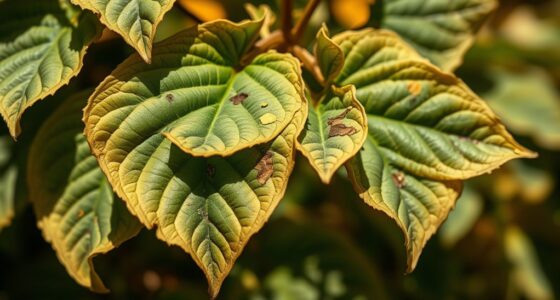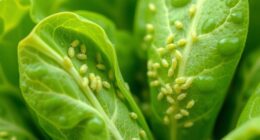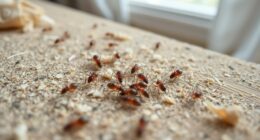If your burning bush leaves are curling, it could be due to environmental stress like extreme temperatures, drought, or too much direct sun, which causes dehydration and damage. Overwatering can also suffocate roots, leading to leaf trouble, while pests like aphids or caterpillars can deform foliage by feeding on it. Fungal diseases might cause curling as well. Keep investigating these factors to restore your plant, and you’ll discover more helpful tips along the way.
Key Takeaways
- Environmental stress like temperature fluctuations, drought, or excessive sunlight can cause burning bush leaves to curl and wilt.
- Pest infestations such as aphids or caterpillars weaken the plant, leading to leaf deformation and curling.
- Poor soil drainage or nutrient deficiencies impair root health, resulting in leaf curling and browning.
- Overwatering or underwatering disrupts moisture balance, causing stress and curling in leaves.
- Fungal infections and viruses can deform and curl leaves; proper pruning and sanitation help prevent these issues.
Signs of Leaf Curling and What It Indicates
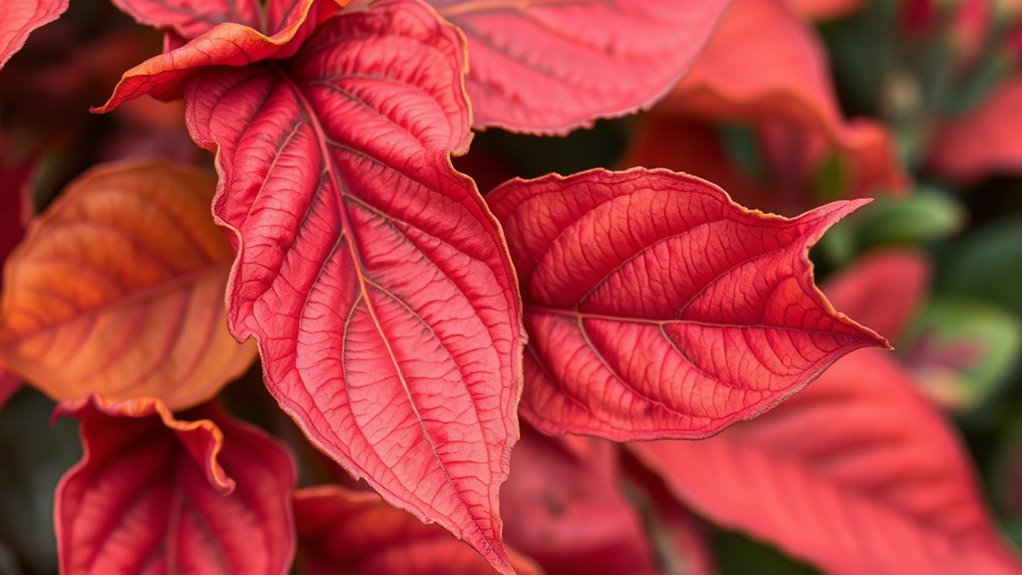
Have you noticed your burning bush’s leaves curling or twisting? This is a clear sign something’s off. Leaf curling often indicates stress from environmental factors or pests. To address this, start with proper pruning techniques to remove damaged or affected branches, encouraging healthy growth. Additionally, evaluate your soil—poor drainage or nutrient deficiencies can cause leaf issues. Soil amendments like compost or balanced fertilizers can improve soil health and help the plant recover. Healthy soil promotes vigorous growth, reducing stress-related leaf curling. Keep an eye on watering habits too; overwatering or underwatering can exacerbate the problem. By combining effective pruning methods with soil improvements, you give your burning bush the best chance to thrive and display lush, healthy leaves. Proper watering and fertilization are also crucial; using plant-specific fertilizers can support overall plant vitality. Incorporating environmental conditions knowledge can further help prevent stressors that lead to leaf curling, especially when understanding how plant stressors impact foliage health.
Drought Stress and Its Impact on Burning Bush Leaves
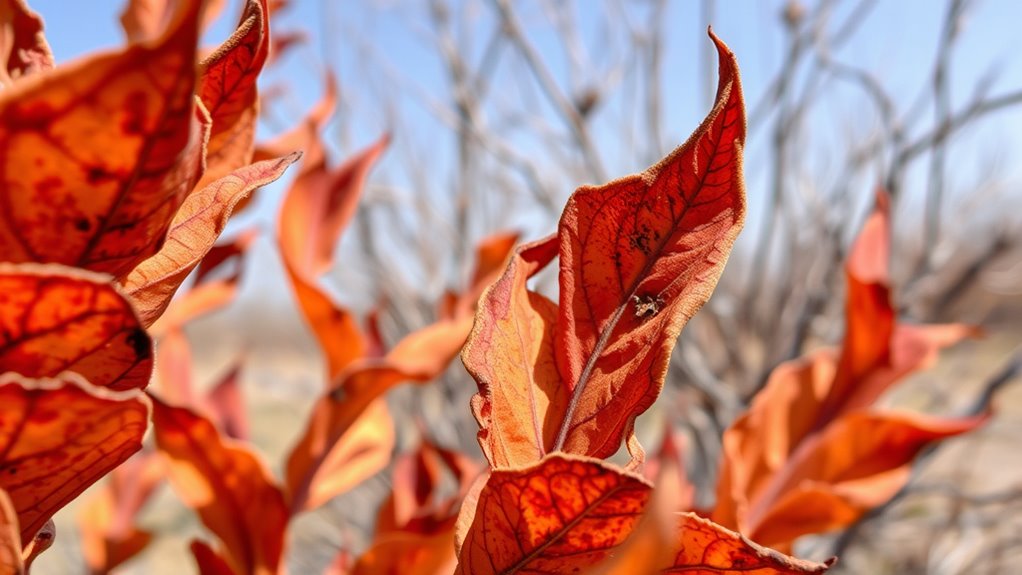
When your burning bush doesn’t get enough water, its leaves can start to curl and wilt. Drought stress limits the plant’s ability to absorb moisture, causing damage to leaf tissues. This reduced water intake makes the leaves more vulnerable to curling and other signs of stress. Additionally, improper tuning of nearby garden equipment can inadvertently stress the plant further, exacerbating its condition.
Drought-Induced Leaf Damage
Drought stress can substantially impact burning bush leaves, causing them to curl and develop damage that compromises their overall health. When soil becomes too dry, it limits root access to water, leading to dehydration in the leaves. Improving soil aeration helps roots access moisture more efficiently, reducing drought effects. Proper pruning techniques also promote healthy growth by removing damaged or stressed branches, encouraging better airflow and water absorption. You should avoid over-pruning, which can weaken the plant further, and instead focus on thinning dense areas to improve soil contact and water penetration. Consistent watering during dry periods is essential, but managing soil health through aeration and strategic pruning can markedly lessen drought-induced leaf damage and support your burning bush’s resilience. Additionally, understanding the importance of soil and water management can help prevent further stress and promote healthier foliage. Incorporating soil moisture retention techniques can further mitigate drought-related issues, ensuring your burning bush remains healthy even during extended dry spells. Maintaining proper plant health practices is also vital for minimizing stress and promoting vigorous growth.
Reduced Water Intake Effects
Reduced water intake directly stresses burning bush plants, causing their leaves to wilt, curl, and eventually turn brown. When soil moisture is limited, the plant struggles to maintain proper hydration, leading to leaf curling as a defense mechanism. Soil pH also influences water uptake; if the pH is too high or low, nutrient absorption becomes inefficient, compounding drought stress. To mitigate these effects, use pruning techniques to remove damaged or overly curled leaves, encouraging healthy growth. Proper pruning also improves airflow and reduces water loss. Ensuring the soil has an ideal pH level supports better water retention and nutrient availability. Consistent watering practices, combined with soil management, help your burning bush withstand drought stress and prevent leaf curling caused by reduced water intake.
Overwatering and Root Health Concerns
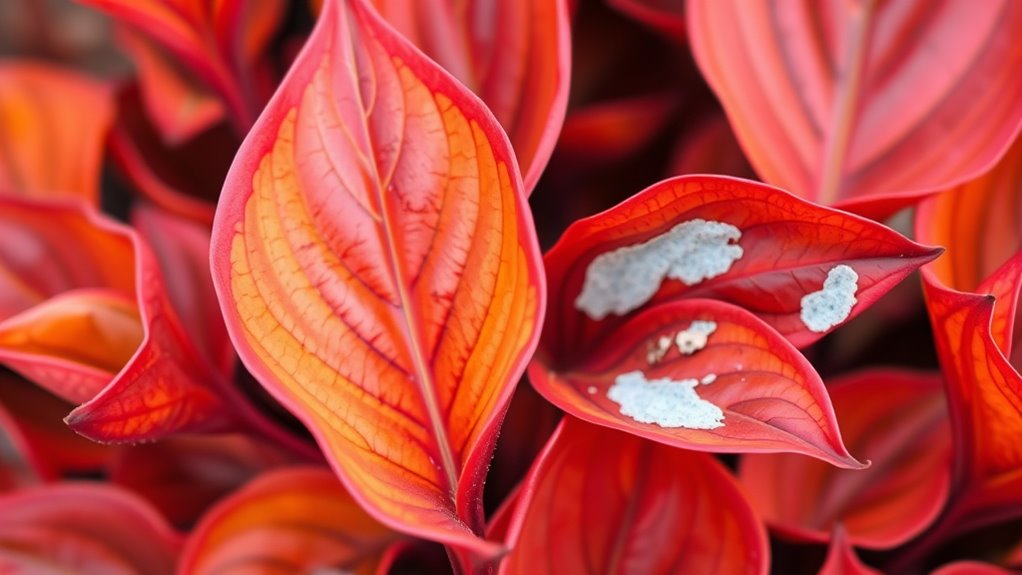
Overwatering can suffocate your burning bush’s roots, leading to poor oxygen flow and weak plant health. When soil stays too wet, it increases the risk of root rot, which can cause leaves to curl and discolor. Keeping an eye on soil moisture helps prevent these problems and keeps your plant thriving. Additionally, maintaining proper watering practices supports overall root health and prevents fungal issues. Proper watering also promotes plant resilience, helping your burning bush recover from environmental stressors. Regularly inspecting your soil’s moisture levels can help you identify overwatering early and adjust your watering routine accordingly.
Excess Water Effects
When you water a burning bush excessively, the roots can become waterlogged, which hampers their ability to absorb oxygen and nutrients. This stress can cause leaves to curl and decline. Overwatering also affects soil pH, making it more acidic or alkaline, which impacts nutrient uptake. Proper pruning techniques help improve airflow and prevent overly dense growth that retains excess moisture. Additionally, understanding Gold IRA Rollovers can contribute to long-term financial stability through diversified investment strategies. To understand water effects better, consider this table:
| Effect | Cause | Solution |
|---|---|---|
| Poor root health | Excess water, soil imbalance | Reduce watering, check pH |
| Leaf curling | Waterlogged roots | Adjust watering schedule |
| Soil drainage issues | Compact or heavy soil | Improve drainage |
| Nutrient deficiencies | Overwatering dilutes nutrients | Use balanced fertilization |
Monitoring soil moisture and adjusting watering practices are key to keeping your burning bush healthy. Proper watering practices help prevent these issues and promote vibrant growth. Additionally, ensuring the soil has good drainage capabilities can significantly reduce water-related stress on the plant.
Root Rot Risks
Excess watering not only affects the surface appearance of your burning bush but also poses serious risks to its root health. Overwatering creates a damp environment that encourages root rot, a common fungal infection. When roots sit in soggy soil, they struggle to access oxygen, weakening the plant’s ability to absorb nutrients. This vulnerability allows fungi to invade and cause rot, which can quickly spread and kill the plant if left untreated. To prevent root rot, confirm you water only when the topsoil feels dry and improve drainage around the roots. Regularly inspect the root zone for signs of fungal infections, such as dark, mushy roots or a foul smell. Maintaining proper watering habits is essential to keep your burning bush healthy and resilient. Additionally, ensuring good filtration systems around the plant can help reduce excess moisture and promote healthy root conditions. Proper soil composition also plays a crucial role in drainage and overall root health. Incorporating drainage techniques can further enhance soil aeration and prevent water accumulation around the roots.
Nutrient Deficiencies That Cause Leaf Abnormalities
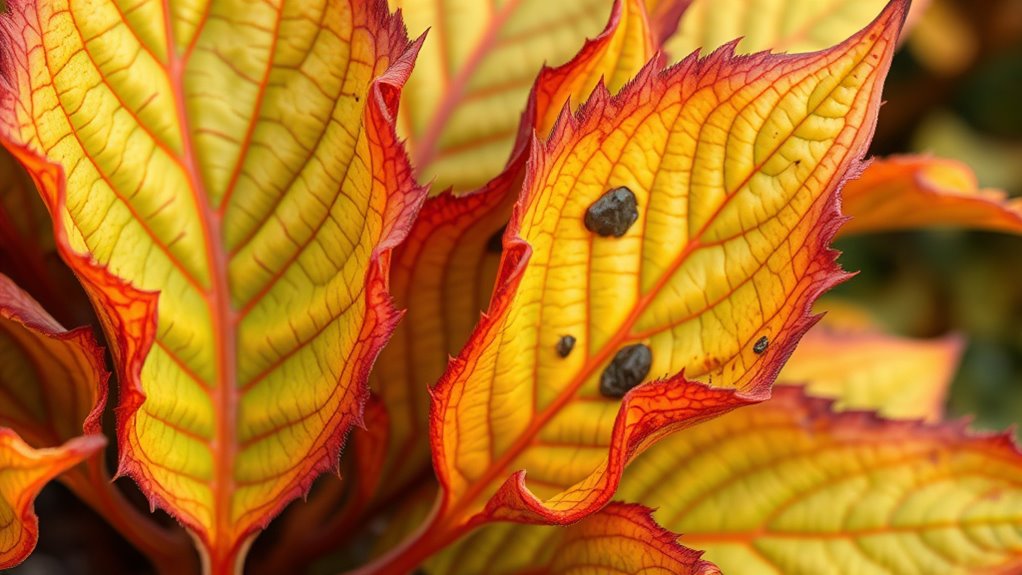
Nutrient deficiencies are a common cause of leaf abnormalities in burning bushes, often leading to curling, discoloration, and poor growth. A soil pH imbalance can hinder nutrient absorption, causing deficiencies even if nutrients are present. When the soil is too acidic or alkaline, essential nutrients like iron, manganese, or zinc become less available, resulting in chlorosis or leaf curling. Micronutrient deficiencies are particularly problematic, as these nutrients are crucial for healthy leaf development. If your burning bush’s leaves curl or fade, test your soil’s pH and nutrient levels. Adjusting soil pH with amendments like lime or sulfur can restore nutrient availability. Additionally, applying a balanced fertilizer formulated for acid-loving plants can help correct deficiencies and promote vigorous, healthy foliage. Incorporating soil testing into your routine can help identify specific nutrient gaps and guide targeted corrections, ensuring your plant receives all the essential nutrients it needs for optimal growth. Regular monitoring and understanding of plant nutrition are vital for maintaining healthy, vibrant foliage.
Environmental Factors: Temperature Fluctuations and Sunlight
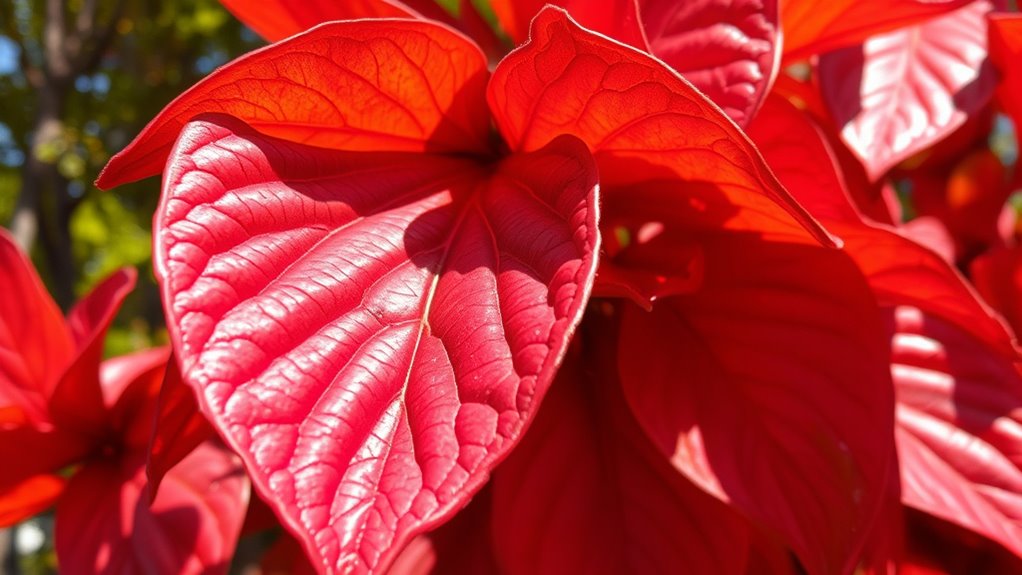
Environmental factors like temperature fluctuations and sunlight exposure play a significant role in the health of your burning bush. Sudden changes in temperature can stress the plant, causing leaves to curl or wilt as it struggles to adapt. Extreme heat or cold disrupts its normal functions, weakening its overall health. Sunlight exposure is equally important; too much direct sunlight can scorch leaves, leading to curling and browning, while insufficient light hampers growth and vigor. Consistent, balanced sunlight helps your burning bush develop strong, healthy foliage. Monitoring temperature fluctuations and ensuring your plant receives adequate but not excessive sunlight can prevent leaf curling and support its long-term vitality. Additionally, understanding plant stress responses can help you adjust your care routines effectively to maintain conducive environmental conditions for your burning bush.
Pest Infestations That Lead to Leaf Curling
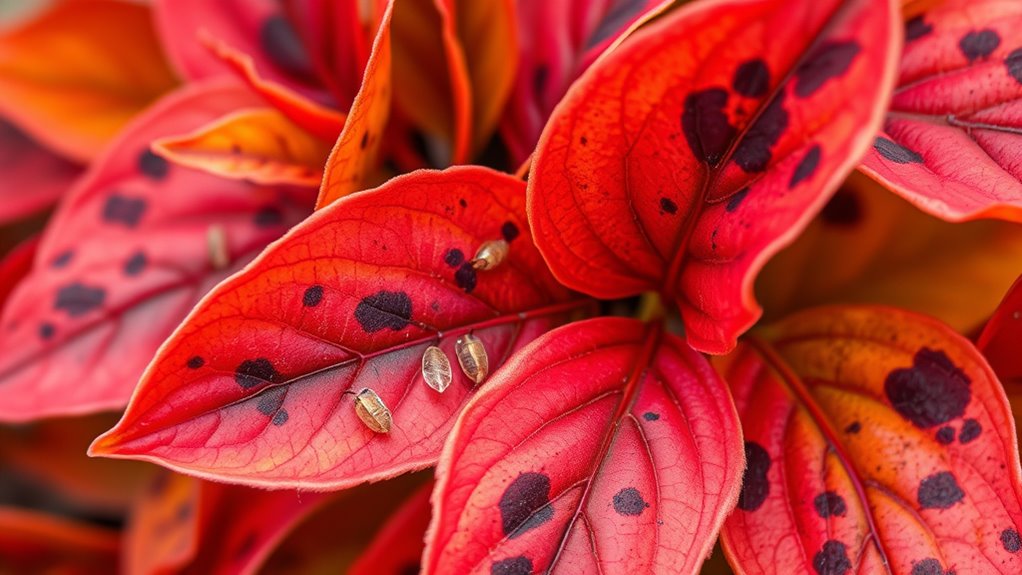
While temperature swings and sunlight issues can weaken your burning bush, pests are another common cause of leaf curling you should watch out for. Caterpillar damage can cause leaves to curl as they chew through tissue, leaving behind ragged edges and weakened foliage. If you notice irregular holes or frayed leaves, caterpillars might be the culprits. Aphid infestations also lead to curling, as these tiny insects suck sap from the leaves, causing them to deform and curl inward. You might see sticky residue or a sticky sheen on the foliage, which indicates aphids. Both pests weaken the plant and make it more susceptible to further stress. Regular inspection and prompt treatment can help keep pest damage in check and preserve your burning bush’s health.
Common Insects Affecting Burning Bush Shrubs

Several insects commonly target burning bush shrubs, causing damage that can lead to leaf curling and overall decline. One major culprit is invasive species like the aphid, which suck sap from leaves and stems, weakening the plant and disrupting nutrient flow. Scale insects also attack, secreting sticky honeydew that promotes mold growth and further stresses the shrub. You might notice these pests thriving in areas with poor soil composition, where plants are less vigorous and more vulnerable. Soil that lacks proper nutrients or drainage can weaken the shrub’s defenses against insect invasions. To protect your burning bush, regularly inspect for pests and consider improving soil quality through amendments. Managing invasive insects early helps prevent severe damage and keeps your shrub healthy.
Disease Conditions Contributing to Leaf Deformation

Disease conditions such as fungal infections and viral pathogens can cause significant leaf deformation in burning bush shrubs. These issues often lead to curling, spotting, or distorted leaves, reducing the plant’s overall health. To help prevent disease spread, consider the following:
- Use proper soil amendments to improve drainage and plant vigor
- Apply appropriate pruning techniques to remove infected or dead branches
- Disinfect tools between cuts to avoid spreading pathogens
- Ensure good air circulation around your shrub
Healthy soil promotes strong growth, making plants more resistant to infections. Regular pruning helps eliminate infected foliage and improves airflow, reducing humidity that fosters fungi and viruses. By maintaining proper cultural practices, you can minimize disease-related leaf curling and keep your burning bush healthy and vibrant.
Preventative Measures and Care Tips to Maintain Healthy Leaves

To keep your burning bush’s leaves healthy and vibrant, adopting proactive care practices is essential. Regular pruning techniques help remove damaged or diseased branches, encouraging healthy growth and airflow. Additionally, soil amendments like compost or organic matter improve soil fertility and drainage, supporting leaf vitality. Keep an eye out for pests or disease signs, and treat promptly. Mulching around the base retains moisture and regulates soil temperature. Here’s a quick guide:
| Care Tip | Benefit |
|---|---|
| Pruning techniques | Promotes healthy growth and removes damaged leaves |
| Soil amendments | Enhances soil quality and root health |
| Proper watering | Prevents stress and leaf curling |
| Mulching | Maintains moisture and suppresses weeds |
Consistent care keeps your burning bush lush and resilient.
Frequently Asked Questions
Can Leaf Curling Be Caused by Chemical Exposure or Pollution?
Yes, leaf curling can be caused by chemical damage or pollution effects. When your plants are exposed to harmful chemicals, like herbicides or pollutants, they may react by curling their leaves as a stress response. Pollution effects, such as airborne toxins or contaminated water, can also damage leaf tissues, leading to curling. To prevent this, avoid chemical overuse and minimize exposure to polluted air and water sources.
Are There Specific Signs to Distinguish Pest Damage From Disease?
When differentiating pests from disease, look for specific signs. Pest damage often shows as holes, chewed edges, or sticky residue, while disease may cause spots, discoloration, or mold. Use pest identification techniques like inspecting undersides of leaves for insects or eggs. Recognizing these symptoms helps you distinguish pest damage from disease, ensuring you apply the correct treatment and keep your burning bush healthy.
How Does Soil Ph Affect Burning Bush Leaf Health?
Ever wondered how soil pH impacts your burning bush’s leaf health? Soil acidity influences nutrient availability; if the pH is too low or high, your plant might struggle to absorb essential nutrients, causing curling leaves. Maintaining a balanced nutrient profile through proper soil pH helps keep your burning bush healthy. Regular testing and adjusting soil acidity can prevent deficiencies and promote lush, vibrant foliage.
What Are Natural Remedies to Prevent Leaf Curling?
To prevent leaf curling naturally, you can use organic sprays like neem oil to deter pests and reduce stress on your burning bush. Regularly inspect your plant for pests or damage, and keep it healthy with proper watering and mulching. Neem oil acts as a safe, environmentally friendly remedy that controls pests without harmful chemicals. These natural approaches help maintain your plant’s health and prevent leaf curling effectively.
Does Pruning Influence the Likelihood of Leaf Curling in Burning Bushes?
Pruning techniques can influence the likelihood of leaf curling in burning bushes by reducing plant stress. When you prune appropriately, you improve airflow and remove damaged or crowded branches, which helps the plant stay healthy. However, over-pruning or improper cuts may stress the plant and increase leaf curling risks. Always prune carefully, focusing on healthy growth, to support overall plant health and reduce curling issues.
Conclusion
By staying attentive to your burning bush’s needs, you can prevent leaf curling and keep it thriving. Address watering issues, provide proper nutrients, and watch for pests and environmental stressors. With consistent care, you’ll guarantee your shrub remains as vibrant as a fireworks display and resilient enough to withstand any challenge. Don’t let leaf curling turn your beautiful plant into a shadow of its potential—nurture it wisely and enjoy a lush, healthy landscape.
